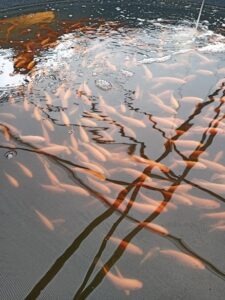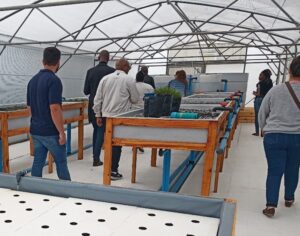A conference on new and advanced techniques in aquaculture, aquaponics, and hydroponics was presented in collaboration with the University of Stellenbosch in Stellenbosch from 22 to 24 November.
Henk Stander, Principal Technical Manager at the Department of Aquaculture at the University, highlighted the development of aquaculture. His presentation provided some background, while others highlighted some aspects of the industry.
Definitions
Aquaculture refers to the farming of aquatic organisms including fish, molluscs, crustaceans, and aquatic plants in all types of water environments. Farming implies a measure of intervention in the rearing process to enhance production, including regular stocking, feeding, and protection from predators. Farming also implies individual or corporate ownership of the stock being cultivated.

The conference was concluded with a visit to the Nembwe Fish Farm, also in Stellenbosch.
Aquaponics is a food production system that couples aquaculture (raising aquatic animals such as fish, crayfish, snails or prawns in tanks) while hydroponically cultivating plants in nutrient-rich water.
Hydroponics is a type of horticulture and a subset of hydroculture which involves growing crop plants without soil by using water-based mineral nutrient solutions in aqueous solvents, or with their roots mechanically supported in an inert medium such as perlite or gravel.
Aquaculture’s growth
Fisheries and aquaculture sectors have been increasingly recognized for their essential contribution to global food security and nutrition in the 21st century. The consumption of aquatic foods has increased at an average rate of 3% per year between 1961 and 2019.
With an annual growth rate of 5,8% since 2010, it is the fastest-growing food-producing sector. In 2018, 114,4 million tonnes of live weight, valued at US$ 263,6 million, was produced. Aquaculture provided more than 50% of the fish consumed globally, and it is expected to grow to 202 million tons by 2030.
Capture production or fishing has plateaued due to overfishing, but the demand is increasing, and aquaculture must fill the gap, especially in Africa.
In Africa, 2 196 million tonnes of aquatic species are produced annually, which is about 2,67% of global production. Nearly all of it (99%) is produced in inland waters. In 2018, Egypt, the largest producer since 1950, produced 71,10%, followed by Nigeria with 13,26% (mainly catfish). South Africa is the 10th largest producer at 0,28%.

In an aquaponic system the fish feed not only has an influence on the growth of the fish, but also on the performance of plants in the system, explains tour leader, Dolly Tuaandi.
In South Africa, production was 6 365,8 tonnes, worth approximately R1 billion, in 2018. These include mainly high-value species such as trout, abalone, oysters, and mussels. Trout is the dominant freshwater species (±1 503 tonnes, valued at about R 98 million), followed by catfish (20 tonnes, valued at ± R0.5 million), and tilapia (571,3 tonnes, valued at ± R25 million).
Marine species contributed about 67% of production by quantity and 85% by value. This is dominated by abalone, with 1 522,2 tonnes in 2018. The estimated value is US$48,98 million. In 2018, the total marine finfish production was about 73,8 tons valued at ± US$5 million, mussel production was about 2 182 tons valued at ± US$2 205 691, and oyster production was about 466.3 tons, worth approximately US$1 132 652.
Developing sectors in South Africa include tilapia, catfish, marron, seaweed (for abalone feed), and prawns. Marine species, including cob, yellowtail, tuna and sole, have high yields and high value, and are dependent on the development of offshore aquaculture technology.
The selection of a suitable species depends on the temperature and quality of water, control of reproduction and the efficiency thereof, the availability of infrastructure and feed technology, as well as marketability.
There are many challenges, including excessively high production costs and a lack of funding. Skills are in shortage, as is a constant power supply. In addition, a stable political environment is lacking, while corruption and a high crime rate undermine profitability. In addition, the industry is still overregulated.
According to Henk, solutions could include the upscaling of aquaculture through the expansion of existing farms, and providing an incubation model for new farms. In addition, new technologies are needed for sustainable intensification and for unlocking the aquaculture potential. It is also necessary to access and develop new markets. It is important to define an aquaculture masterplan, train people, apply research, and, quite importantly, gain government support.
As happy as a fish in … saltwater. In this experiment at the University of Stellenbosch, tilapia are kept in water with a high saline level. The salicornia plants grown in this system can be used as a healthy alternative to salt.
Uncomplicating aquaponics
Colin Bremner of Kleinskuur Aquaponics believes aquaponics need not be complicated, as many believe. “We can imitate nature as closely as humanly possible by observing, learning from, and using the solutions provided by nature.”
He said the natural water cycle with evaporation and rain must be imitated by pumping the water. “You can build a patchwork using many pumps to get the water to where you want it to go at the rates you need, or you can uncomplicate this process with a proper design which must be a true recirculating system. Plan the level of every component properly to enable gravity to do its work and use pipe thickness and other design methods to determine flow rates.”
Despite aquaculture being hailed as the fastest-growing farming sector in the world, South African aquaculture is still lagging and faces a lot of challenges.
He said bacteria and other living organisms convert waste through nitrification and mineralisation to nutrients for plants. “Just make sure there is proper water flow, especially on the bottom of your fish dam, and throughout your whole system, because you want to encourage good aerobic bacteria to do their work and not denitrification caused by anaerobic bacteria.”
Since there are often fine particles in the gravel section, you must ensure all the water can drain properly.
Vulnerable communities
Unathi Sihlahla, Director INMED South Africa, explained how social entrepreneurship help upscale aquaculture and aquaponics in South Africa.

The conference included a tour to the University of Stellenbosch’s commercial aquaponic unit where different methods of growing plants are being explored.
Inmed Aquaponics® strengthens food security in vulnerable communities, and provides the necessary training and economic development for women, the youth, and people with disabilities to create sustainable incomes and build stronger communities.
Unathi said: “Despite aquaculture being hailed as the fastest-growing farming sector in the world, South African aquaculture is still lagging and faces a lot of challenges.
To embrace aquaponics, small-scale farmers need:
- an appropriate technological approach suitable for smallholder farmers by being cost-efficient and productive;
- a comprehensive understanding of all economic aspects of aquaponics;
- an enabling environment with a favourable regulatory framework, government support, and a simple authorization system;
- a reliable supply of fish fingerlings and quality feed for fish; and
- funding mechanisms suitable for smallholder farmers, including those with low literacy levels.
Feed
Ryan Weaver, technical support, and Sales Manager at Specialised Aquatic Feed Farm, said management practices that will negatively impact feed performance include:
- feed must be stored in a dry, cool storeroom off the floor and 10 cm away from the walls;
- rough feed handling and transport may cause the feed to break up into dust;
- feeding strategy must prevent overfeeding and underfeeding; and
- water quality in the production system must remain excellent because poor water quality will result in reduced feed visibility and uptake.
Nutrient recycling
Carel van Heerden, founder of Green Stream Nutrients, said if the correct nutrient ratios are present, crops grow and metabolise more effectively. This results in the more effective use of nutrients, which reduces the need for nutrient supplementation. This leads to decreased required volume flows and therefore infrastructure. With the correct balance between the nutritional needs of the aqua life, plants and microbes, the predicted design parameters are closer to the actuals. Green Stream Nutrients provide a turnkey solution for aquaponics.

Colin Bremner of Kleinskuur Aquaponics explains the importance of proper drainage in gravel systems to allow aerobic bacteria to effectively convert fish waste into plant nutrients. This KSBA96 system was recently completed in Stellenbosch.
Quality control
Estelle Kempen of the Department of Agronomy at the University of Stellenbosch said an estimated 45% of South Africa’s total available food supply is being lost or wasted yearly, with the primary production stage of the food cycle on farms being a major contributor.

In the Kleinskuur Aquaponic systems, fish are kept in nets in a self-cleaning raceway dam to make management and handling easier.
Environmental factors, like unseasonal weather, destructive pests and diseases can damage entire crops at a time, leading to enormous wastage. Poor planning in the pre-harvest and production phase, incorrect use of pesticides and a lack of training also lead to losses. Produce that does not meet quality standards is not only a huge financial concern for producers and markets, but it is also a large contributor to food waste and the sustainability of our growing systems.
Estelle said: “Protected cultivation systems or greenhouses and hydroponics enable us to minimize the biotic and abiotic pressures on our crops, allowing for better quality products.”
Contact Henk Stander at hbs@sun.ac.za for more information.










